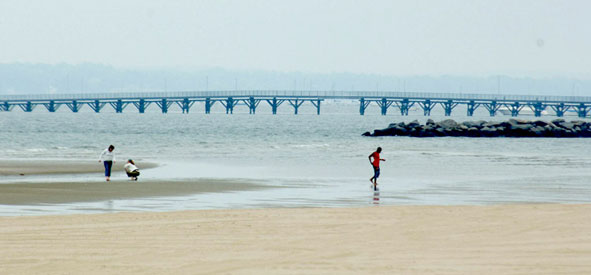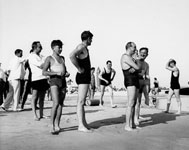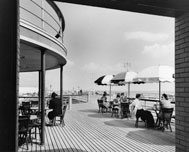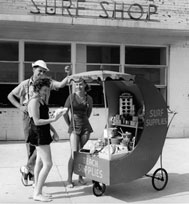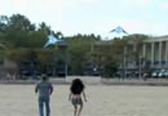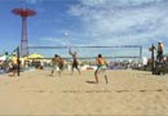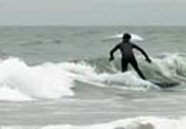History of City–Owned Beaches
Find information about NYC’s beaches, their hours, and locations at the Beaches webpage.
By the late 1920's, the City had established Jacob Riis Park, the Coney Island boardwalk, and a few small waterfront parks in Brooklyn and Queens that catered mainly to day-trippers. At Wolfe's Pond Park on Staten Island, in portions of the Rockaways, and at Pelham Bay Park in the Bronx, large bungalow communities took root. Construction of the boardwalk at Rockaway began in 1927, and over the decades it has been expanded and improved. During the height of the 1927 beach season, the population of Rockaway reportedly swelled from 70,000 to 250,000 people.
Robert Moses, who was responsible for so much development as Commissioner of Parks from 1934 to 1960, first found success at Jones Beach on Long Island, perhaps to be expected for someone who was such an avid swimmer. As Long Island State Parks Commissioner, Moses oversaw the design and construction of Jones Beach, just beyond the City's limits. Jones Beach opened in 1929; the massive public works project dredged sand from the ocean floor to create a beach where none had been. Nautical details infused the design of the bathing facilities and even the uniforms of employees who worked there. Moses' design theme influenced decorative elements later used at Riis Park, Rockaway and Orchard Beach, among other city beaches.
In the early years of publicly improved beaches in New York City, the borough presidents controlled land acquisition and improvements. In 1938, under a Charter Revision, jurisdiction was transferred to the Parks Department. As commissioner, Robert Moses set out to expand and make the beaches more wholesome. Just before the Parks Department gained full control of the beaches in 1938, he commented, “No inland lake, stream or pool can compete with the Ocean and its tributaries which surround the City.” Vast improvements followed.
In Pelham Bay Park in the Bronx, what was once a crowded mass of summer cottages on the shore of Long Island Sound was converted into a vast sandy public beach when the water between Rodman's Neck and Hunter Island was filled to create Orchard Beach's wide crescent. New boardwalks went up at South and Midland Beaches in Staten Island, Coney Island, and at Rockaway and Jacob Riis Parks. Public works like the Belt Parkway and the Marine Parkway Bridge improved beach access both for private vehicles and buses. Moses found financial support for beaches in federal programs like the Works Progress Administration as Parks demolished deteriorating music halls, carousels, shooting galleries, and dilapidated earlier boardwalks, and replaced them with this new boardwalk and related beachfront facilities, such as the case as with South and Midland Beaches.
After World War II, beach attendance soared, and the City acquired more coastland, including Manhattan Beach. By the time Moses left office in 1960, public beaches had increased from 1 to 17.96 miles. His successors have faced operational hurdles of almost biblical proportions, contending with storms, fires, sewage, and ordinary litter.
Jacob Riis Park
260-acre Riis Park, stretching over a mile on the western section of the Rockaway Peninsula, was acquired by the city in 1913. In 1914, the beach was named for Danish-born photo journalist and social reformer Jacob August Riis, once a Queens resident. The original bathing pavilion was built in 1932 and could handle up to 8,000 users. In 1934, Commissioner Moses announced plans to upgrade Riis Park with a $1.7 million investment, including a new bathing pavilion, parking field, pitch-'n-put golf course, and a 40–foot wide mile–long boardwalk. The bathhouse was designed by Parks´ chief architect Aymar Embury II whose team used an economical style of simple structural planes and a palette of materials like brick, limestone, and granite.
If the turn of the century amusement parks catered to a more hedonistic element, the facilities built in the 1930s were focused on health and betterment. Jungle gyms were a standard feature of the several hundred playgrounds built by the Parks Department in the 1930s, and as part of the comprehensive program to overhaul the city's beaches, adjacent recreation facilities were installed for children and adults. Rather than simply vegetate on the beach, visitors were encouraged to stretch and build muscle tone each day at 11:00 a.m., 2:00 p.m. and 4:00 p.m., in group calisthenics led by Parks recreational department supervisors.
Each year, millions of patrons use city beaches, and their maintenance and upkeep can be very expensive. Tons of garbage must be hauled out each and every day, and on busy days, this figure can rise as high as 14 tons. That is why in 1974, during the fiscal crisis, Riis Park in Queens and Great Kills on Staten Island were transferred, along with Jamaica Bay, from City to Federal jurisdiction as the Gateway National Recreation Area. Since 1974, Riis Park has been part of the federal Gateway National Recreation Area; currently the National Parks Service is in the latter stages of a $20 million rehabilitation of the historic bathing pavilions.
Orchard Beach
Early in the 20th century, several park areas in the vicinity of Pelham Bay in the northeast Bronx became popular for camping and bathing. They included tent colonies and primitive wooden bathing bungalows at Hunter Island, Rodman's Neck, and Eastchester Bay. By 1908 there were more than 200 bathhouses, and by 1914, summer crowds on Sundays and holidays were estimated at 5,000. By the late 1920s, attendance had grown dramatically, and at times the rudimentary accommodations were overwhelmed by the huge numbers of people flocking to the shore. The City Island Civic Association expressed concerns about the permit-letting procedures, and a few years later, under Commissioner Moses, the City moved in to clean up the chaos.
Although the move disappointed the bungalow dwellers, in the 1930s the City kicked them out and created an expansive and welcoming ambiance at Orchard Beach, down to manicured flower beds at the parking field approach. The design and layout of Orchard Beach were conceived as a complete experience, where visitors could avail themselves of a variety of concessions encircling a large veranda set back from the hot summer sun. At the center of the mile-long crescent beach are colossal bathing pavilions evocative of the Trocadero in Paris. The terraced area facing the Long Island Sound is home to food outlets and shops.
Most amazingly, a monumental $8 million project added 115 acres of land by importing white sand from the Rockaways in Queens and Sandy Hook, New Jersey, to join Rodman-s Neck and Hunter Island. The improvement included a 90,000-square-foot bathhouse with a restaurant and other concessions, a 50-foot-wide promenade parallel to the shore, a 1,400-foot-long and 250 & foot-wide mall, and a massive parking field.
Manhattan Beach
The portions now occupied by a public beach were acquired by the Federal government in 1942 as a Coast Guard and Maritime Training Station. Eight years later, the land was turned over to the City as a way to alleviate the “inhuman overcrowding” at nearby Coney Island. An additional 24 acres were acquired in 1954, and the combined property was improved and opened in 1955, though never connected by a proposed boardwalk to Coney Island and Brighton Beach.
